Hawk Henries has been making hand-carved wooden flutes since as long as his daughter Sierra, 34, can remember. “He’s one of a very small handful of people doing the work that he does in the traditional way,” she says. “So, his work is really precious in the world, and of course he won’t say that, but it’s important that people know about it because it’s knowledge that he’s carrying in his work.”
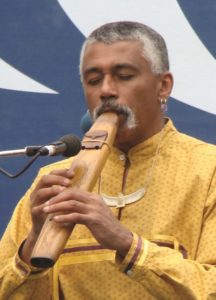
Hawk and Sierra are staying at the Weidlinger house in Wellfleet this week as part of a residency supported by the Cape Cod Modern House Trust and the Wampanoag Arts Foundation. Hawk is performing on and talking about some of his flutes at an event at Wellfleet Preservation Hall on Sunday, Oct. 17.
Hawk and Sierra are members of the Nipmuc tribe. They live in Sullivan, Maine, on Frenchman Bay northeast of Mt. Desert Island. Though Sierra doesn’t play the flute, she is also an artist, working mainly in birch bark. She makes intricate designs using a wood-burning tool and X-Acto knife. Sierra says she feels fortunate to have been influenced by many art shows and pow wows growing up.

Though they pursue different disciplines, both Sierra and Hawk work with wood. “There’s this prevailing disconnect in the world regarding the beings that we live beside every day — birds, water, mountains, and trees,” says Sierra. “Art is a way to build on the relationships we have with these other beings and to gain a better understanding of them and more respect and desire to care for them.”
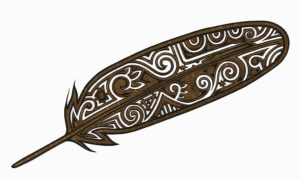
Birch bark has many traditional uses, including canoes, baskets, and the walls of homes. “It has a lot of amazing properties,” explains Sierra. “It’s anti-bacterial and, though I wouldn’t necessarily recommend this, it has been used to wrap wounds. It’s a fire starter. It’s been used for centuries for record keeping.”
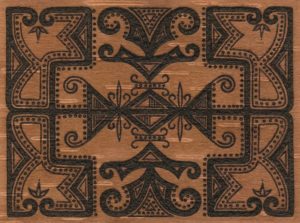
Hawk is entirely self-taught as a Nipmuc flute player and maker. He is also a composer, having collaborated with the London Mozart Players and artists including Yo-Yo Ma. “Before the flute, I didn’t play any musical instruments, except maybe the radio,” says Hawk. “This sounds so clichéd, but one day, about 30 years ago, I was listening to a recording, and I thought, ‘I need to play this instrument.’ ”
After a few years, Hawk was able to get his hands on a traditional instrument he could afford. “Something one day said to me, ‘Why don’t you try to make the voice of this flute better.’ I ruined it in literally five minutes. It took a half a year for me to figure out how to make it play again.” The challenge of figuring out how it worked is what started Hawk on his path.
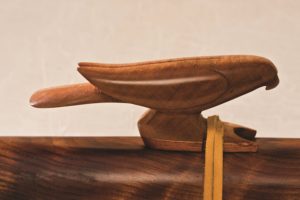
“A flute, musically, is a hollow tube, sometimes with finger holes, always with some kind of opening to allow you to put your breath into it,” he explains. “Once your breath enters the tube, the tube vibrates at a particular velocity, and you can adjust the sound with the finger holes, or by the speed with which you blow into the flute itself. That’s basically it. Any hollow tube can be a flute. It’s kind of embarrassing when you’re at Home Depot and you walk down that aisle with all the PVC pipes and you start playing them like flutes and your family looks at you like you’re silly.”
The flutes that Hawk makes are technically “two-chambered end-blown block flutes,” Hawk explains. “A classical flute has one chamber that’s completely hollow for the length of the tube. The flutes that I play are not that way — they have two separate chambers divided by a solid wall.” The carved piece tied at the top, called a block or a bird, helps direct the air from the first chamber into the second. Hawk uses only hand tools and natural materials, including walnut oil as a finish.
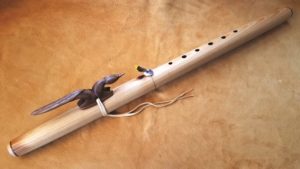
Hawk views his relationship to the flute as an extension both of himself and of his culture. “But well beyond the culture, it’s a tool for expression, which is even more ancient,” says Hawk. “Music for me is a way to articulate my gratitude for life, to express how much I love looking at a bird or a tree or listening to the ocean. To oversimplify it, it’s a tool for prayer. It’s a ceremonial tool, and yet it’s none of that. Playing the flute certainly connects me with culture, but it also connects me with an understanding of my relationship to Earth and to sky and to the things that live in those places.”
Breath by Breath
The event: A performance and talk by Hawk Henries
The time: Sunday, Oct. 17, 3 to 5 p.m.
The place: Wellfleet Preservation Hall, 335 Main St.
The cost: Free
